Blog
What Makes Adhesive Products Work?
Everyone knows that adhesives stick things together, but have you ever stopped to think how the sticking process actually works? If you’d like to understand the basics of what makes adhesives work – without getting bogged down in too much scientific jargon and technical language. Adhesive products come in a wide range of formulations, each designed for specific bonding applications. – read on!

Archaeologists tell us that adhesives have been around for thousands of years – Stone Age man apparently used naturally occurring tacky substances to fix sharpened flints to sticks of wood, creating the first tools and weapons. Many industries rely on adhesive products for their versatility and strong bonding capabilities.
From an early age, we all learn how to stick things together. In nursery classes, children are taught how to make a collage by cutting out pictures from a magazine and sticking them to sheets of coloured paper. If you’re of a certain age, you may even remember making your own glue by mixing flour and water together – probably not the most effective adhesive ever created, but it sort of worked.
A bit about the science of adhesives and what makes adhesives work
When two things stick together, there are two basic forces at work – cohesion and adhesion. Both properties are needed to form a bond. Cohesion is the ability of the adhesive substance to hold itself together, and adhesion is its ability to stick to other things. From tapes and glues to sealants and epoxies, adhesive products play a crucial role in construction and manufacturing.
Think about a jam sandwich – if you pull it apart, some jam will be left on both slices of bread. This shows that jam is better at adhesion (sticking to the buttered bread) than cohesion (holding itself together). So while there’s no denying that jam is sticky, it’s only really adhesive and cohesive enough to hold two slices of bread together.

Why are there so many different types of adhesives?
Basically, if jam were better at cohesion and adhesion, we probably wouldn’t need any other types of glue. Adhesive products have evolved over time, offering environmentally friendly options with low VOC emissions. Seriously though, here are some of the main reasons why so many different types of specialist adhesives have been developed to suit different jobs:
- Material types: Some materials have a porous surface which allows the adhesive to sink in and create a bond; other materials (e.g. stone and glass) are non-porous, meaning the adhesive product can’t sink in and has to work simply on the surface.
- Weight: Lighter things clearly stick together more easily than heavier things, because much greater adhesive/cohesive strength is needed to hold the heavy things together.
- Situation: The effect of gravity has a lot to answer for here – for example, a greater adhesive/cohesive strength is needed to stick tiles to a wall or ceiling than a floor.
- Conditions: Depending on where it is being used, an adhesive product may need to be able to withstand extremes of temperature or air pressure, exposure to moisture or very dry air, or even work underwater.
- Properties: In many cases, adhesives need to match the properties of the things they are sticking together – the best example of this is rubber adhesive, which wouldn’t be much use if it was hard and inflexible.
- Speed: In some situations, it may be fine to allow the adhesive time to bond and harden – in others, instant grab adhesive may be called for.
When choosing adhesive products, it’s essential to consider factors like adhesion strength and cure time to ensure a successful bond. At Anglo Adhesives, we manufacture a wide range of specialist adhesives to stick virtually any material to any surface – check out our products here, or contact us for technical support and advice.
So, why doesn’t adhesive stick to its container?
Some adhesives can be solvent based, or water based. This means that the adhesive compound itself has been mixed with either solvent or a water to produce the adhesive product. The process of cohesion and adhesion only occurs when the product is allowed to ‘cure’ as it dries. The other types contain no solvents or water, so they are classed as being based on 100% solids. Adhesive products have found their way into the healthcare sector, where medical-grade adhesives are used in wound closures and surgical applications. These may require heat to be applied to them so that they melt then as they cool, they ‘set’ as they return back to a solid material. These are known as Hot (or Cool) Melt Adhesives. The other types of 100% solids adhesives rely on a reaction to cure or set. That’s why superglue doesn’t stick to the inside of its tube – but will stick to virtually everything else when it’s exposed to the air, including your fingers if you’re not careful!
Enjoyed our blog on what makes adhesives work? Find out more about Anglo Adhesives, or contact us today to discuss your adhesive needs.
You can view our reviews for our Acrylic Bath Repair Kit on Trustpilot.
You can also stay up to date with our latest company news & blogs on